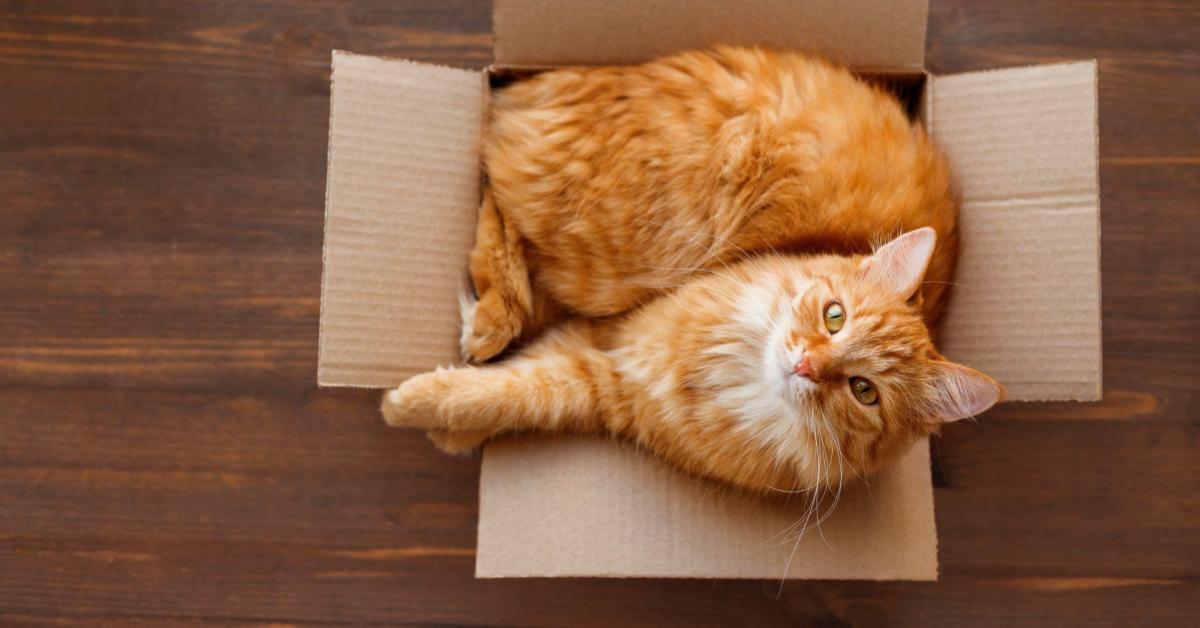Have you ever wondered why your cat can’t resist hopping into a cardboard box? It turns out, this cat behavior is more than just a quirky feline fascination. In this article, we’ll explore the reasons behind the common question: “Why do cats love boxes?”
1. Safety and hiding
Cats are natural hunters, and in the wild, they seek out enclosed spaces for safety and to stalk their prey. Even though your fluffy friend may not be an ambush predator like big cats, the instinct to find hiding places and a cozy hiding spot is still deeply ingrained.
Not to mention, cats can be easily stressed, so having a designated safe zone, like a box, offers them a stress-free haven. When they feel overwhelmed or anxious, retreating to a hiding box provides a sense of security and regulates stress levels.
2. Body heat and insulation
Cats love warmth, and a cardboard box provides insulation that helps retain their body heat. Just like big cats in the wild, domestic cats have a preference for cozy spots that keep them warm. It’s their way of creating a safe and comfortable space.
It’s important to note that while cardboard boxes are great insulators for cats, you should always monitor the temperature of their environment, especially in extreme weather conditions. Always provide options for your cat to move to cooler areas if needed so their body temperature remains regulated.
3. Curiosity
Cat owners know what curious creatures their pets are when it comes to just about anything. Just like a new toy, a new box introduces an element of novelty. The exploration of a new environment, especially one with different hiding places, stimulates their senses and satisfies their curious nature.
4. Territorial Instincts
Cats are territorial animals, and a box can serve as a small, confined space that they consider their own. This satisfies their instinctual need for a defined territory within your home.
Cats will also use scent marking to establish and claim their territory. When a cat rubs against or sits inside a cardboard box, they leave their scent on it, marking it as part of their territory. This behavior helps them feel more secure and in control of their environment.
5. Play and enrichment
Boxes offer a perfect setting for play and enrichment. Cats love to engage in playful behavior, and a box becomes both a toy and a potential hiding spot from which they can pounce on imaginary prey.
Cardboard boxes can also be an excellent option for cat scratching. Their fibrous material allows cats to sink their claws in, providing a good scratching experience. This natural behavior helps cats maintain healthy claws and stretch their muscles. Not to mention, cardboard boxes are readily available and often inexpensive. Additionally, if the box becomes too worn, it can be easily replaced.
Tip: To enhance the appeal of a cardboard box for scratching, you can encourage your cat by sprinkling catnip on it or placing a few treats or pieces of cat food inside.
How to kitty-proof empty boxes
Allowing your cat to play in a box can be a delightful and enriching experience, but it’s essential to prioritize their safety. Here are some safety tips to keep in mind as you kitty-proof your home (and the boxes that come with it!):
- Check for hazardous materials: Before letting your cat explore a box for the first time, ensure there are no hazardous materials inside. Remove any tape, staples, or strings that might pose a choking or digestive hazard.
- Choose the right size: Ensure that the box is an appropriate size for your cat. It should be spacious enough for them to move around comfortably but not so large that they may get lost or trapped inside. Cats often prefer small spaces that make them feel secure.
- Avoid sharp edges: Inspect the box for any sharp edges or protruding objects that could potentially harm your cat. If necessary, tape or cover sharp edges with materials like cardboard to prevent injuries.
- Provide ventilation: If the box is enclosed, make sure there are adequate ventilation holes or openings. This prevents your cat from feeling trapped and ensures they have steady airflow while playing or taking a snooze.
- Provide an exit: If the box is deep or has a lid, make sure your cat can easily enter and exit. This is crucial to prevent your cat from feeling trapped and anxious.
- Ensure box is in a safe area: Place the box in a safe environment, away from potentially dangerous items or areas. Ensure there are no heavy objects that could fall onto the box, and keep the play area free from electrical cords or other hazards.
- Monitor for stress: Pay attention to your cat’s behavior. If they show signs of stress, such as rapid breathing, excessive vocalization, or attempts to escape, it’s time to intervene and provide a calm and safe space.
By following these safety tips, you can create an enjoyable and secure play environment for your cat while they explore the wonders of a simple cardboard box.
As you can see, the love that cats have for boxes is deeply rooted in their instincts. Whether you have a house cat or an outdoor cat, a simple cardboard box can fulfill their need for shelter, warmth, and play. So, the next time you see your cat nestled in an Amazon box, know that it’s not just a box – it’s a source of comfort and joy for your feline friend.




